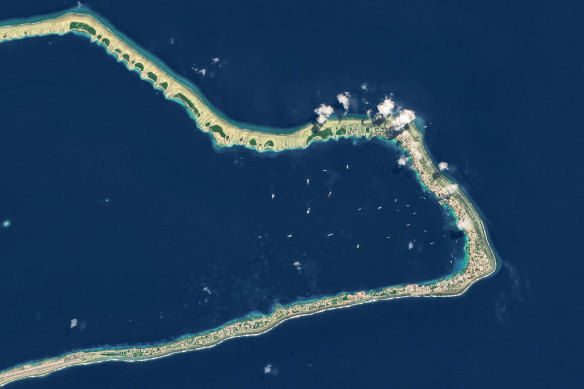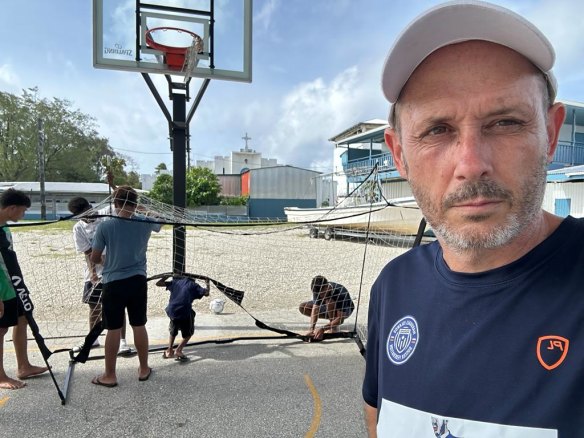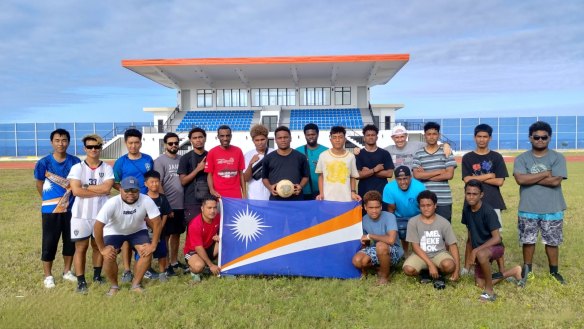By Vince Rugari
On 11 April 2001, the Socceroos played American Samoa in a FIFA World Cup qualifier. Australia famously prevailed 31-0, the biggest victory in international soccer history - a performance so bad and a result so one-sided it led to changes to the qualification process and inspired two separate feature films on soccer in American Samoa, a documentary and a dramatisation, both called Next Goal Wins.
Consider for a moment that there are lower depths than this to plumb in the world game. Approximately 3000km to the north is a country we can probably say would lose 31-0 to American Samoa - that is if they could manage to get 11 players together to play.

A satellite view of Majuro, the capital of the Marshall Islands.Credit: Getty
The Marshall Islands, population 42,000, is the last remaining sovereign nation on the planet without a national team. There are five skinny islands, 29 atolls, limited room for organised outdoor sport, and precisely zero football: no clubs, no leagues, no fields, no goalposts, barely even any balls.
That was until three English blokes decided this was an injustice that needed to be corrected.
Annexed by Germany in 1885, then occupied by Japan during World War I, the Marshall Islands have a heavy American influence which can be traced back to World War II when the United States took over. Between 1945 and 1958, the US conducted 67 nuclear tests on Bikini Atoll (yes, that’s where the bikini got its name), the most visible legacy of which is a huge concrete dome on Runit Island containing radioactive waste. And there’s a crack in it, which doesn’t bode particularly well for the future.
The American influence shines through in mostly bad ways. The US dollar is the local currency, but it costs $1 to buy a single tomato, and so locals are reliant on imported foods - mostly canned goods or starchy carbs like pasta and rice. As such, the country is ranked seventh in the world for obesity rates and are projected to become No.1 by 2026. They are also among the highest in the world for diabetes. Basketball is the most popular sport, but not many people are particularly active.
Oh, and then there’s the existential threat of climate change. A one-metre rise in sea levels would flood 40 per cent of buildings and wipe out entire islands, according to a study conducted by the Marshall Islands government and the World Bank in 2021.
A ‘compact of free association’ allows Marshallese citizens to travel freely to and from the US, and around 30,000 of them have moved there permanently, with half of that number settling in Arkansas, where one local community has been lovingly dubbed ‘Springdale Atoll’.
A handful of these migrants have gone on to represent the Marshall Islands at the Olympics - but when it comes to the world’s most popular sport, there is simply nothing doing, although thanks to their surprisingly excellent internet connection, many young kids have grown up idolising Lionel Messi, Cristiano Ronaldo and Kylian Mbappé. The demand is growing.
The Marshall Islands Soccer Federation was established in 2020 by a group of local volunteers and enthusiasts. It is not the first attempt to make soccer ‘happen’ there - Michael Slinger, an Australian businessman who moved there in 1991 and married a local woman, was part of a group of expats and Pacific Islanders who once tried and failed - but it is easily the one with the most momentum behind it.

Justin Walley is one of the three Englishmen trying to help build football in the Marshall Islands from the ground up.
When Matt Webb, a Brit who works in marketing but has been involved in football all his life, read an article about the renewed efforts to spread the gospel of soccer and form a Marshallese national team, he immediately saw a story that could resonate globally, and an opportunity to raise awareness of their health and climate challenges.
Independently, aspiring coach Lloyd Owers also learned of the developments and reached out to the federation to get involved. He is now the national technical director; Webb is in charge of marketing and sponsorship.
Another chap, Justin Walley, is the press officer. Walley has plenty of experience on soccer’s outermost margins; he now lives in Bosnia, but has founded a club in Latvia, coached in Sierra Leone, and steered Matabeleland (a region of Zimbabwe) at the 2018 CONIFA World Cup, the tournament for minorities, Indigenous peoples or other cultural groups which aren’t recognised by FIFA.
We would say he has made a career out of it, but that might be slightly overstating it.

Could these lads be part of the Marshall Islands’ first national team?
“It’s never paid,” Walley says. “Most of what I’ve done has been kind of voluntary, or expenses or whatever. But on the plus side, it’s taken me to some wild and interesting places, and some priceless experiences, which is what it’s all about, ultimately.”
When Owers was appointed as technical director, he gave Walley a call asking for advice. Instead, Walley asked to get involved, too. He spoke to this masthead on the last day of his visit; he was only the second member of the ‘imported’ trio to have made it out there, with most of the work towards building a national soccer structure being conducted remotely.
It takes two days to get to the capital Majuro from Europe, via Los Angeles and Hawaii, and it’s not cheap. The money for the trip was raised mostly through crowdfunding, sponsorships and the sale of a national team shirt, which was promptly snapped up by football hipsters and jersey enthusiasts in love with the concept bringing the game to the last place on earth without it. An away jersey is coming.
Will it ever be worn by an actual national team? Walley is hopeful a friendly could take place as soon as this year. The shortcut method would be to pick a diaspora 11, and the federation’s spies in the US are already identifying possible candidates - but that would just be to tick a box.
The ambition is to build something real and lasting, and the first bricks are being laid. Walley helped put on two separate tournaments for adults and children, supported by foreign sponsors, although they had to play futsal on a basketball court rather than proper 11-a-side on grass. A proper field is coming, though - a national stadium is currently being built to host the 2024 Micronesian Games, and there is just enough room inside the athletics track to squeeze one in.
“I got the lads down [there], kind of a national team meet-up, and said: ‘This is where you’re going to play. I want you to look at it, I want you to think about it, I want you to have a vision of one day playing here,’” Walley says. “I’ve gone into schools here with the sports ministry, they’ve been happy for me to go in and guest coach PE. So the other day, I had 140 kids over three hours. It was organised chaos in the midday sun, but it was great. I had little group of kids around eight or nine years old, and the girls were unbelievable. They were so into it. They loved it.”
Romance should not cloud reality. Slinger says he is “not optimistic” unless the new federation can find a regular source of funding to meet the onerous requirements to become a member of FIFA or the Oceania Football Confederation. The latter has not even returned Walley’s emails or calls. “I’m hoping that’s not on purpose,” Walley says.
He describes it as a classic chicken and egg scenario: the federation needs to prove it’s serious about football to be admitted, but it’s hard for this volunteer-run, donation-reliant operation to do much more than what they have done without more money. And they won’t get that from any official sources until they’re taken seriously.
A possible circuit-breaker? A documentary.
“That could be a game changer for us,” Walley says. “All the rubbish that’s on Netflix, the last country on earth without football would be an amazing documentary. And we already have lots of bits of film. We’ve spoken to lots of people, producers and companies who have been very interested, but then we realised we’re just not getting anywhere with them, so we’re down to two or three now.
“Maybe someone will read this, and pop-pop-pop - you never know.”
Watch every match of the UEFA Champions League, UEFA Europa League and UEFA Europa Conference League on Stan Sport. All the action streaming ad-free, live and on demand, with select matches in 4K UHD.